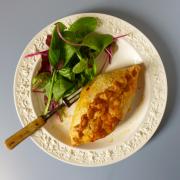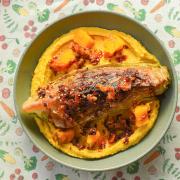There are few more comforting sights on a chilly January day than a steamed pudding sitting proud on a plate. And when you cut it open and the fragrant beefy filling spills out, it’s time to tuck in your bib and reach for a knife and fork.
These days we’re more likely to fill a pudding with steak and kidney, but in Victorian times oysters were a key ingredient. They were dirt cheap and the poorer you were, the more oysters you’d have in your pie. Nowadays the opposite is true. But a tin of smoked oysters won’t break the bank and they marry beautifully with the beefy flavours.
I’ve used red wine in this recipe but traditionally a stout is used. The choice is yours. Just swap them over. The pudding works well with mashed potatoes and a selection of colourful vegetables.
About Linda
Linda Duffin is a food writer who operates a cookery school, Mrs Portly’s Kitchen Classes, from her beautiful Tudor home in mid-Suffolk. Students are invited, in season, to plunder the kitchen garden and orchard in her two-and-a-half-acre garden for ingredients and can also book a stay as part of a course. Linda works closely with local producers, some of whom join her in teaching classes in their specialist areas. The Mrs Portly name, Linda says, started as a joke but she has grown into it. mrsportlyskitchen.co.uk
Beef, Mushroom and Smoked Oyster Pudding (serves 4)
For the filling:
3-4 tbsp extra virgin rapeseed oil (I use Hill Farm’s)
500g beef shin, trimmed and cut into bite-sized pieces
1 large onion, peeled and chopped
2-3 heaped tbs plain flour
300ml red wine
500ml hot, strong beef stock
Bouquet garni
3 large flat mushrooms
Large knob of butter
1 tin of smoked oysters, drained and roughly chopped
For the pastry:
200g self raising flour
100g suet
Pinch of salt
Water
Heat 2 tbsp of oil in a large deep frying pan (one with a lid) or casserole and brown the meat in batches, adding more oil if necessary. Scoop onto a plate.
In the same pan sauté the onions, sprinkled with salt, until soft and browned. Spoon onto the plate with the beef. Add the butter and another dash of oil and cook the mushrooms and their chopped stalks to drive off excess water. Set two whole mushroom caps aside. Chop the third and add it to the meat and onions.
Put the meat, onions and chopped mushrooms back in the pan on a medium heat and stir through the flour. Add the red wine, stirring until thickened, then the warm stock. Season with black pepper and a little more salt. Tuck in the bouquet garni, bring to a boil, then lower to a simmer and cook for about one and a half hours or until the meat is tender. Check and adjust the seasoning and thicken the gravy further if required.
With a slotted spoon, scoop the meat, onions and mushrooms into a bowl with enough of the sauce to moisten them well. Stir through the roughly chopped smoked oysters. Allow to cool. Set the remaining sauce aside for gravy.
Take a 1 litre/17cm diameter pudding bowl and grease with softened butter. In another bowl, mix the self raising flour, suet and salt. Gradually add cold water, stirring with a table knife until you have a soft, stiff dough. You may need a splash more water but don’t overdo it, it shouldn’t be sticky.
Cut off a generous quarter of the pastry for the lid. Pat both pieces of pastry into balls. Flour your worktop well and roll out the larger piece to 1cm thickness, around the diameter of a dinner plate. Slide it into the bowl and mould it so it’s the same thickness throughout. Trim off any excess. Roll out the lid and put to one side.
Put about a third of the meat mixture in the bottom, add a mushroom, then continue to layer, ending with the last of the meat. Dampen the top edge of the pastry with a small amount of water and put on the lid, sealing the edges well.
Cut a double layer of baking paper in circles about 10cm bigger than the top of the pudding bowl. Make a small pleat across the middle to allow for the pudding to expand and tie on tightly with string. Tie a layer of foil, pleated in the same way, on top. Tie some string to make a handle so the pudding will be easier to lift.
If you have a stovetop pressure cooker you can save time and fuel by following the method outlined by Catherine Phipps in her book Modern Pressure Cookery (Quadrille, 2022). Put a trivet in the bottom and add 5cm of just-boiled water. Stand the basin on the trivet and put on the lid without sealing. When lots of steam has been generated, steam without pressure for 15 minutes, then close the lid, bring up to high pressure and cook for at least 45 minutes. Allow the pressure to drop naturally.
Alternatively, put a trivet or upturned saucer in a large deep pan, place the pudding bowl on top and add enough boiling water to come halfway up the basin. Clamp on the lid and steam gently for two hours, checking the water level from time to time. Top up if necessary with boiling water from the kettle.
When the pudding is done, remove it carefully from the pot, and let it sit from five minutes. Take off the foil and paper. Gently loosen the edges with a palette knife and invert onto a serving plate. Heat the extra gravy and serve on the side, pouring a little over the top of the pudding if you like.



























